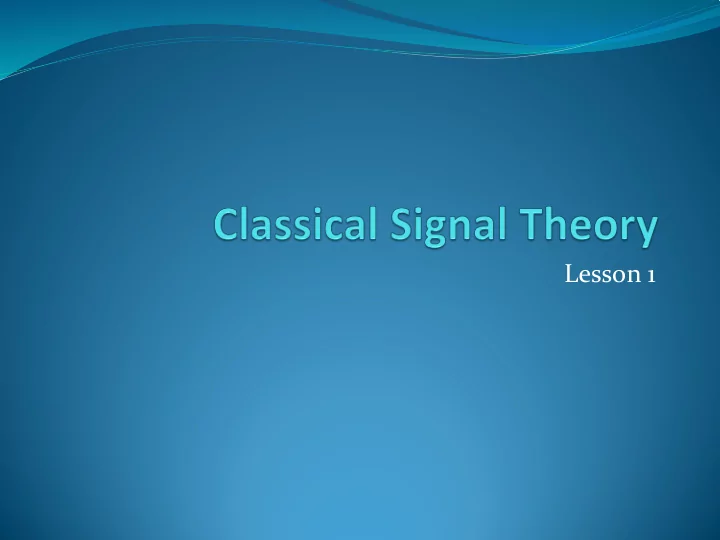

Lesson 1
Continuous Signals A continuous-time signal is a complex function of a real variable that has, as a codomain, the set of complex numbers. Real signals:
Periodic Signals Periodic signals: where the condition is satisfied for T p and for kT p where k is an integer. Periodic repetition formulation:
Continuous Signals A signal is even if: A signal is odd if: An arbitrary signal can be always decomposed into the sum of an even component s e (t) and an odd component s o (t)
Continuous Signals Causal signal: Time shift: Area: Mean value:
Continuous Signals Energy: Specific power:
Definitions over a period Mean value over a period: Energy over a period: Power over a period:
Example of a signal A sinusoidal signal: It can be written as: Using Euler’s formulas: It becomes: it can be written as the real part of an exponential signal:
Some useful signals The step signal: Where the unit step function is: The rectangular function:
Some useful signals A triangular pulse: The impulse: Can be seen as a limit as D tends to zero.
On the impulse
The sinc pulses The periodic sinc
Convolution Given two continuous signals x(t) and y(t) , their convolution defines a new signal: This is concisely denoted by: If we define: The convolution becomes:
Convolution In conclusion, to evaluate the convolution at the chosen time t , we multiply x(u) by z t (u) and integrate the product.
Convolution In this interpretation, we hold the first signal while inverting and shifting the second. However, with a change of variable v = t − u , we obtain the alternative form in which we hold the second signal and manipulate the first to reach the same result.
Convolution example We want to evaluate the convolution of the rectangular pulses
Convolution example We evaluate the convolution of the signals
Convolution of a periodic signal The convolution of two periodic signals x(t) and y(t) with the same period T p is then defined as: where the integral is over an arbitrary period (t 0 , t 0 + T p ) . This form is sometimes called the cyclic convolution and then the previous form the acyclic convolution .
The Fourier Series We recall that in 1822 Joseph Fourier proved that an arbitrary (real) function of a real variable s(t) , t ∈ , having period T p , can be expressed as the sum of a series of sine and cosine functions with frequencies multiple of the fundamental frequency F = 1 /T p , namely
The exponential form A continuous signal s(t) , t ∈ R, with period T p , can be represented by the Fourier series Where:
Some properties of the Fourier Series Time shift: Mean Value: Parseval’s theorem:
Examples A real sinusoid: A square wave:
The Fourier Transform An aperiodic signal s(t) , t ∈ , can be represented by the Fourier integral: And
Interpretation In the Fourier series, a continuous-time periodic signal is represented by a discrete frequency function S n = S(nF) . In the Fourier Transform, this is no more true and we find a symmetry between the time domain and the frequency domain, which are both continuous. In the Fourier Transform a signal is represented as the sum of infinitely many exponential functions of the form
Properties For real signals the Fourier Transform has the Hermitian Symmetry: Time shift: Frequency shift: Convolution:
Examples Rectangular pulse and sinc function Impulses
Examples Periodic signals Signum signal Step signal
Recommend
More recommend